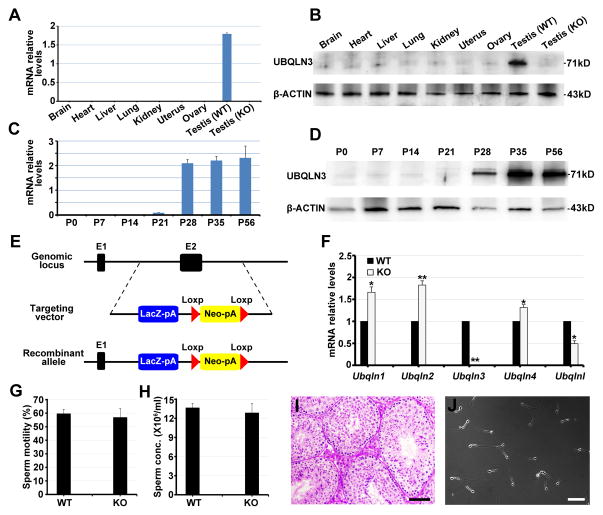Increasing lines of evidence suggest that the ubiquitin-proteasome pathway (UPP) plays a key role in spermatogenesis (Hou and Yang 2013). Ubiquilins are Ubiquitin-like proteins, all of which contain an amino-terminal UBL domain and a carboxy-terminal ubiquitin-associated (UBA) domain in its structure. Among all Ubiquilin proteins identified so far, Ubiquilin 3 is the only one that has been reported to be testis-specific (Conklin et al. 2000). By examining the expression of Ubqln3 mRNAs and protein in 8 different mouse organs using quantitative PCR (qPCR) and Western blot, we found that Ubqln3 was indeed expressed exclusively in the testis, with both transcript and protein detectable in the testes starting at postnatal day 28 (P28); the highest levels were detected in adult testes (Fig. 1A–D).
Figure 1.
Ubqln3 is a testis-specific gene dispensable for spermatogenesis. A: qPCR analyses of Ubqln3 mRNA levels in 8 organs of adult mice. B: A representative Western blot showing that UBQLN3 is exclusively detected in wild-type (WT) but not in Ubqln3 KO testes. (The rabbit polyclonal UBQLN3 antibody (1:1000) was purchased from ProteinTech Group, Inc. (Chicago, IL.), catalog number 13568-1AP.) C: qPCR analyses of Ubqln3 mRNA levels in developing testes. Testes at postnatal day 0 (P0, newborn), P7, P14, P21, P28, P35, and P56 were analyzed. D: A representative Western blot showing UBQLN3 expression in developing mouse testes. E: Schematic illustration of the targeting strategy for generating a Ubqln3-null allele in mouse embryonic stem cells. F: qPCR assays showing mRNA levels of five Ubiquilin family genes in Ubqln3 KO testes. *P<0.05,**P<0.01 compared to WT (n=3, Student’s t-test). G and H: Normal sperm concentration and sperm motility in Ubqln3 KO males. I: Normal histology in Ubqln3 KO testes and epididymides. J: Representative phase-contrast micrograph showing Ubqln3 KO sperm. Scale bars, 100 μm (I) or 50 μm (J).
The onset of testicular Ubqln3 expression at P28 coincides with the elongation steps during late spermiogenesis, suggesting that Ubqln3 is mainly expressed in elongating/elongated spermatids. To define its physiological role in the testis, we generated Ubqln3 global knockout mice (on the C57BL/6J background) using a targeted embryonic stem cell line (cell-line number 11472C-G12) obtained from the Knockout Mouse Project repository; in this case, a gene-trap cassette (LacZ-pA) had recombined with exon 2 of Ubqln3, leading to a “gene trap” allele (Fig. 1E). Neither Ubqln3 mRNAs (Fig. 1F) nor UBQLN3 protein (Fig. 1B) was detected in homozygous knockout mice, suggesting that these animals are truly Ubqln3-null (herein called Ubqln3 KO mice). Both male and female Ubqln3 KO mice were viable and displayed normal development, with no discernable differences in growth compared to wild-type (WT) mice. Together, these data indicate that Ubqln3 is dispensable for embryonic and postnatal development in mice.
To determine the fertility of Ubqln3 KO males, we performed a fecundity test using Ubqln3 KO males bred with fertility-proven adult, WT females. Our breeding data showed that no significant difference in either litter size or litter interval compared to those WT breeding pairs over a 6-month period (data not shown), suggesting that Ubqln3 KO males are fertile. Consistent with their normal fertility, both sperm count and sperm motility are comparable between gametes isolated from Ubqln3 KO and WT males (Fig. 1G–H) and histological analyses of Ubqln3 KO testes and epididymides demonstrated normal spermatogenesis and sperm morphology (Fig. 1I–J). Taken together, these data indicate that Ubqln3 is not required for male germ-cell development or spermatogenesis in mice. Interestingly, Ubqln1, Ubqln2, and Ubqln4 transcript abundance was increased significantly in Ubqln3 KO compared to WT testes (Fig. 1F), suggesting that other member of the Ubiquilin family may compensate for the loss of Ubqln3. Therefore, the testis-specific expression of Ubqln3 is dispensable for both embryonic development and spermatogenesis in mice.
Acknowledgments
This work was supported, in part, by National Institutes of Health (NIH) Grants HD060858, HD071736, and HD074573 (to W.Y.).
References
- Conklin D, Holderman S, Whitmore TE, Maurer M, Feldhaus AL. Molecular cloning, chromosome mapping and characterization of UBQLN3 a testis-specific gene that contains an ubiquitin-like domain. Gene. 2000;249(1–2):91–98. doi: 10.1016/s0378-1119(00)00122-0. [DOI] [PubMed] [Google Scholar]
- Hou CC, Yang WX. New insights to the ubiquitin-proteasome pathway (UPP) mechanism during spermatogenesis. Molecular biology reports. 2013;40(4):3213–3230. doi: 10.1007/s11033-012-2397-y. [DOI] [PubMed] [Google Scholar]



